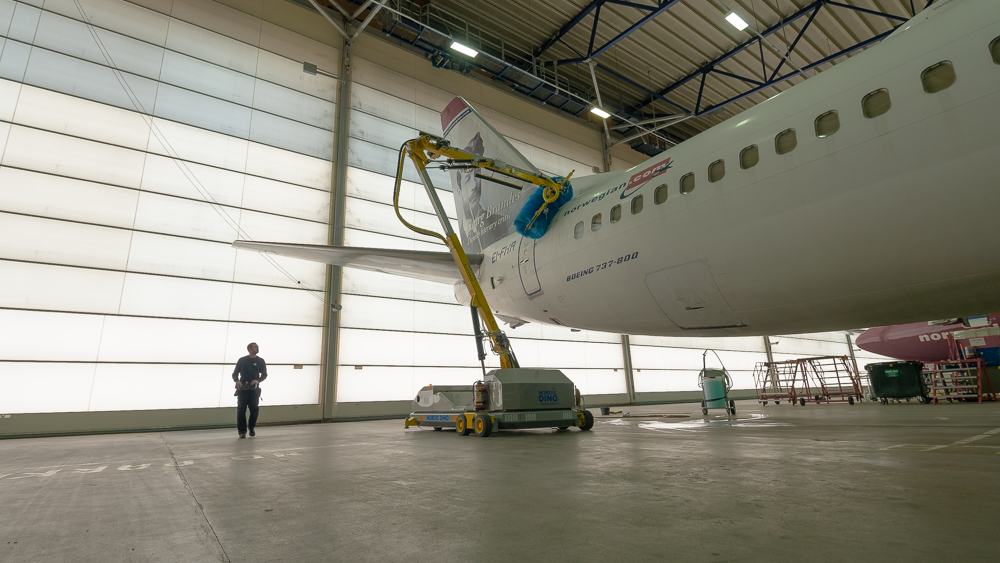It is no secret that the outside of an aircraft can be a hub for grime, fluids, and dirt of all kinds. Unlike their interiors, the exterior of aircraft is almost constantly exposed to the elements and will confront debris and dirt at high speed. However, aircraft can come in all shapes and sizes, and if one is concerned with their cleanliness, an obvious question arises: What makes some aircraft dirtier than others, and which aircraft types stand out for being the dirtiest? Nordic Dino, the world’s leading automated aircraft washing solutions developer and subsidiary of Avia Solutions Group, provides a breakdown of the dirtiest aircraft types its robots have made spotless.
“The level of filth that needs to be cleaned on an aircraft will generally depend on how the aircraft is flown as exposure to elements changes based on where it operates,” Veronika Andrianovaite, Chief Commercial Officer of Nordic Dino Robotics AB, said. “We can always tell when an aircraft has visited deserts and tropical regions as these regions have their own challenges.”
For sandy environments such as deserts and coastal areas, cleaning becomes even more essential as the damage from these elements can accumulate rapidly. Such environments have previously caused disputes with airlines and aircraft manufacturers after the corrosion caused damage that was identified during inspection. This is because of the corrosive nature of sand.
“Besides deserts and coastal regions, we also see a wide variety of different dirt and residue on aircraft after operations in tropical areas,” Andrianovaite said. “Tropics create climates of storms which produce mud and insects. That is combined with humidity, which decreases the evaporation rate, causing stains to become more widespread.”
Tropical environments and their extreme heat and humidity cause aircraft to work harder, which ultimately results in more stains. As aircraft move in and out of heated environments, there are also expansions of rubber materials and joints in seals, which can sometimes cause small leaks of fluids that then emerge.
It’s in these hot environments of tropics and deserts that we find the most need for cleaning, but there is also an unpleasant nature to the task of cleaning itself. While all tasks outside on the ramp of an airport require working in harsh elements, a robot offers additional time savings, reducing the amount of time exposed to such elements as well as the physical labour required in these harsh environments.
Besides environmental factors, some planes can be exposed to dirt based on aircraft type, as different aircraft will demonstrate different operating characteristics that will change how each frame is exposed to dirt and foreign contaminants. This would include aircraft which either operate low to the ground or have a longer takeoff and landing distance.
“Some ramp crews refer to slower aircraft with the nickname ‘bug smashers’ because these aircraft operate in a manner that exposes them more to flying through insects,” Andrianovaite said. “Some of the ramp crews have reported seeing a trend for dirtiness in the CRJ and 757 types.”
The CRJ and 757 each have different characteristics when operating on the runway. While the CRJ remains low to the ground, which causes more opportunity for exposure, the 757 is known for having more powerful engine options, combined with a longer fuselage.
“These fuselages translate into larger canvases for the dirt and grime to paint on,” Andrianovaite said. “It’s important to note that the study of how dirt accumulates on aircraft is not exact, and we see both exceptions of these stereotypes, and I don’t think the dirt buildup is always airframe specific.”
In summary, aircraft types can have a relationship with the rapid accumulation of dirt depending on how they are used. For aircraft used in tropical or sandy environments, more rigorous cleaning practices are needed to prevent corrosion and confront the elements they encounter. For other types, how the aircraft are flown, and what altitudes they are operating at, will influence how dirt is accumulated. In any case, there is no exact science to how dirt and grime is built up on aircraft. What is clear is that the lack of cleanliness correlates to real corrosion of the exterior of the airframe and prevents the detection of structural faults. Therefore, to maintain maximum aircraft safety, as well as the value of proper presentation of an airline brand, all aircraft should be treated equally when it comes to proper cleaning as a part of aircraft maintenance and airline brand development.
